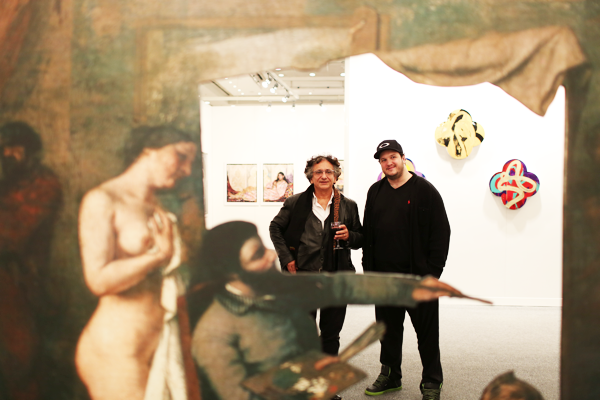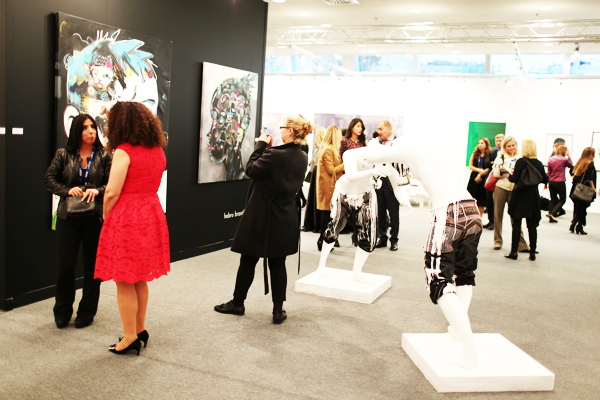Galleries
Will Contemporary Istanbul Win Turkey’s Art Fair Fight?
With Art International snapping at its heels, the veteran rival changes tack.
With Art International snapping at its heels, the veteran rival changes tack.
Coline Milliard

After an exponential rise in the last decade, the art market in Turkey is entering into a new phase. The major players in Istanbul seem to think that there simply aren’t enough Turkish collectors around to sustain further growth: internationalization is thus very much on the agenda. The city’s two main contemporary art fairs embody the trend. While continuing to serve its home crowd, the country’s oldest contemporary fair, Contemporary Istanbul—which opened to the public yesterday—is more than ever courting international exhibitors and buyers. But competition is rife. And as of last year, Contemporary Istanbul is not the only one hoping to attract foreign collectors to town. The arrival in September 2013 of Art International, courtesy of art fair veteran Sandy Angus, is symptomatic of Western dealers’ push to foster stronger relationships with collectors in this part of the world. But can either one of them truly turn Istanbul into the market hub for the region at large, in the same way Hong Kong is the art marketplace for Asia?
The truth is that the country’s volatile political situation isn’t particularly enticing for foreign businesses. When Art International was confirming its inaugural exhibitors in late spring 2013, the Gezi Park protests unfurled as a backdrop. President Recep Tayyip Erdoğan’s administration, once seen by the West has a buffer against Islamization, has become synonymous with severe censorship and systematic crackdowns on civil liberties. Post-Gezi, the Turkish Lira dropped significantly in value.
As champagne glasses clinked along the Bosphorus to celebrate the opening of Contemporary Istanbul this week, Syrian refugees continued to pour into Turkey, joining the estimated 1.5 million people who have already made the journey. Battles were ongoing in Kobane at the Syrian border. The fair’s founder and chairman Ali Güreli assured artnet News that the recent events hadn’t had “any impact” on the fair, nor the art environment in Istanbul. Yet one can’t help but wonder how long the market will remain oblivious.
For now at least, it is. Art International is finding its public. Visitor numbers have jumped from a mere 5,000 in 2013 to 20,000 this year. While the figures pale in comparison of the 75,000 expected at this year’s edition of Contemporary Istanbul, they do show that Art International has secured a spot on the art map. This, despite numerous hurdles, including a lawsuit launched by Contemporary Istanbul, which has accused the foreign fair of using a name it had previously copyrighted. A smattering of blue chip Western galleries made the trip to Istanbul last September, including Leila Heller and Paul Kasmin from New York, Vienna’s Galerie Krinzinger, and London’s Lisson Gallery, prompting one commentator to write, perhaps a little prematurely, that Art International had “unmistakably established itself as the more substantive of the city’s two art fairs.”

Contemporary Istanbul 2014
Courtesy Contemporary Istanbul
I’d argue that the bets are still off. True, none of art market’s top names come to Contemporary Istanbul: as at Art International, there’s no Gagosian, no Hauser & Wirth, no David Zwirner in sight, nor does one spot many of the artist-brands omnipresent in the world’s leading fairs from New York to Hong Kong. Yet as co-founder of the Moving Museum Aya Mousawi pointed out: “Contemporary Istanbul is difficult to judge by Western standards, but it caters to a local audience.” One often hears criticism of the quality of the art on display at Contemporary Istanbul. An Istanbulite described the fair as “the Grand Bazaar.” Yet, he added, “everything shifts, so everybody’s happy.” The relative affordability of the works on offer, and Turkish collectors’ still-palpable loyalty to their home scene, brings about swift transactions. Now in its ninth year, Contemporary Istanbul remains the contemporary art market highlight of the year in Turkey.
“You have to do it if you want to be a contemporary art gallery here,” Feza Velicangil, the director of the young Istanbul gallery Sanatorium, told artnet News, adding that there were clients, including Turkish clients, she only sees at the fair. The bubbly dealer sold a large Arabic-inspired acrylic on paper by Erol Eskici in the fair’s first few hours for 20,000 TL ($8,912). And contrary to what one often hears, Contemporary Istanbul isn’t a mainly Turkish fair. Out of the 108 galleries exhibiting this year, less than half are from Turkey, the rest haling from 22 countries including South Korea, Russia, and the US.
Talking to artnet News, Contemporary Istanbul chairman Güreli claims to have buried the hatchet with Art International, and to find the new addition to the city’s art scene “very positive.” “If you only focus on Turkish collectors, two fairs won’t work,” he said. “That is why Art International and us are both focusing on having more collectors from all around the world.” Yet very few foreign buyers made it to Contemporary Istanbul’s vernissage on Wednesday evening. Turkey’s top dynasties were the stars of the night: spotted about the aisles were Füsun Eczacıbaşı and Oya Eczacıbaşı, Aylin and Özcan Tahincioğlu, Ali Dinçkök, and Sevda and Can Elgiz, who founded Istanbul’s first private museum in 2001.
Their endorsement is significant. They belong to the handful of people who have built the Istanbul art scene and market, virtually from scratch. Talking to artnet News, Sevda Elgiz remembered that, when she and her husband started to collect 30 years ago, “contemporary art was completely unknown in Turkey.” The couple traveled to buy art abroad. “It was really hard to explain to our friends, who were wondering why we were buying this stuff.”
It caught on. And with no public funding for contemporary art, both the market and the institutional scene is ruled by these powerful families. Many have now set up their own museums. The Eczacıbaşı are behind both IKSV (Istanbul Foundation for Culture and Arts), which manages the critically-acclaimed Istanbul Biennial and Istanbul Modern; meanwhile the Koçs are behind Arter, and several organizations bear the name of their benefactors, including Borusan Contemporary, and the Sakıp Sabancı Museum.

Contemporary Istanbul 2014
Courtesy Contemporary Istanbul
The creation of these foundations has inevitably fueled the market, as has the Turkish appetite for diversified investments. Turkey is going through the typical emerging market cycle. Like the Chinese before them, Turkish collectors who at first enthusiastically embraced their country’s art production are starting to move to Western art. According to a local art insider, despite the growing success of Turkish art at auction—according to artnet Analytics, the top five Turkish artists at auction all have records above $10 million—some collectors found themselves unable to shift some of their early acquisitions and are looking for established artists which offer “more of a guarantee.” The pool of collectors itself has changed. Contemporary Istanbul chairman Güreli was quoted in Flash Art estimating that the number of collectors in Turkey increased from 50 in 2005 to 700-800 in 2013, 20-30 of whom spend on average $100,000-150,000 a year. The rest of them are part of a younger collector base rising from Turkey’s rapidly growing middle and upper-middle class.
“In the last 10 years, the Turkish economy has tremendously developed: the size has more than tripled, from $3,000 per capita it went to $11,100,” Güreli told artnet News. “The target of the government is to reach $1.3 trillion in 2018, which is equivalent to $16,000 per person. That means that people will be spending much more money on art.” With its lower price point, Contemporary Istanbul is an attractive proposition for these new collectors, and Güreli is making every effort to secure their loyalty, including a new initiative, CI Editions. “It’s a learning stage,” continued Güreli. “The purpose of CI Editions is to encourage them to buy more art. And we expect, we hope, that they’ll become very strong collectors in the future.” What remains to be seen, however, is whether Contemporary Istanbul will manage to cater to the upper crust of the global collector-base and the growing regional middle class simultaneously.
Judging by the dealers artnet News spoke to, middle market buyers were very much driving things during the fair’s first day. Among the reported sales were a neon piece by Fırat Engin representing the Olympic rings as coffee cups and cheekily entitled Istanbul 2024 (an allusion to the city’s many applications to the host the Games), which quickly went for 16,500 TL ($7,346) at art ON Istanbul. The more established Galerie Lelong, which came with Joan Miro bronzes priced up to €400,000, started the fair by placing a picture by Ramazan Bayrakoğlu, Wet Leaves (2014) for €48,000. At the lower end of the scale, art at the booth of the young Georgian Project Art Beat was flying off the wall, with pictures by painters-to-watch Sopho Chkhikvadze, Maka Batiashvili, and Irakli Bugiani selling in the €1,500–5,500 range.
This middle market appears to be where Contemporary Istanbul excels. Unlike Art International, which seems to focus exclusively on trying to woo the international elite, this larger but more modest base is a solid foundation—one which has a realistic potential for growth. If the big collecting names of the West don’t make it to Contemporary Istanbul, the fair still has a clientèle to fall back on. And perhaps this is the group it should concentrate on rather than continuing its wild-goose chase of the global elite. Art International, on the other hand doesn’t really seem to have a plan B.